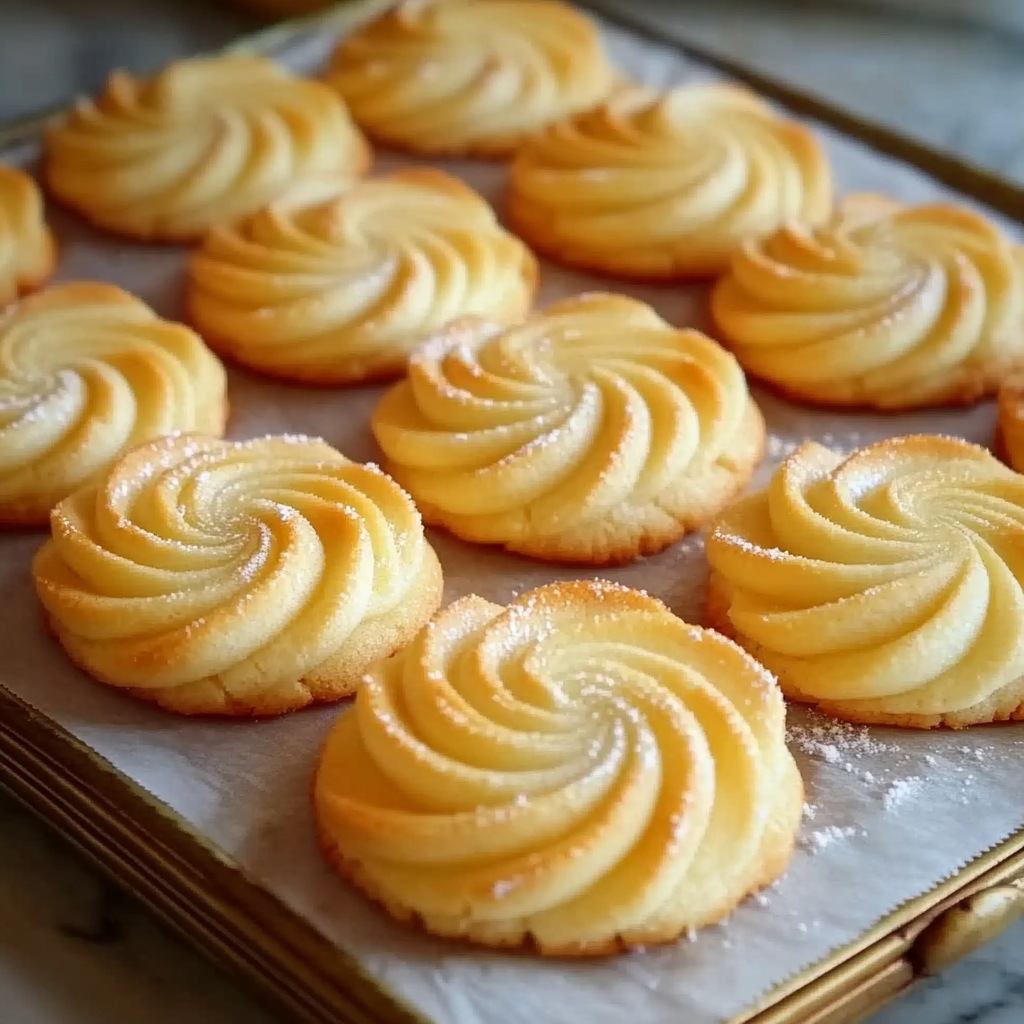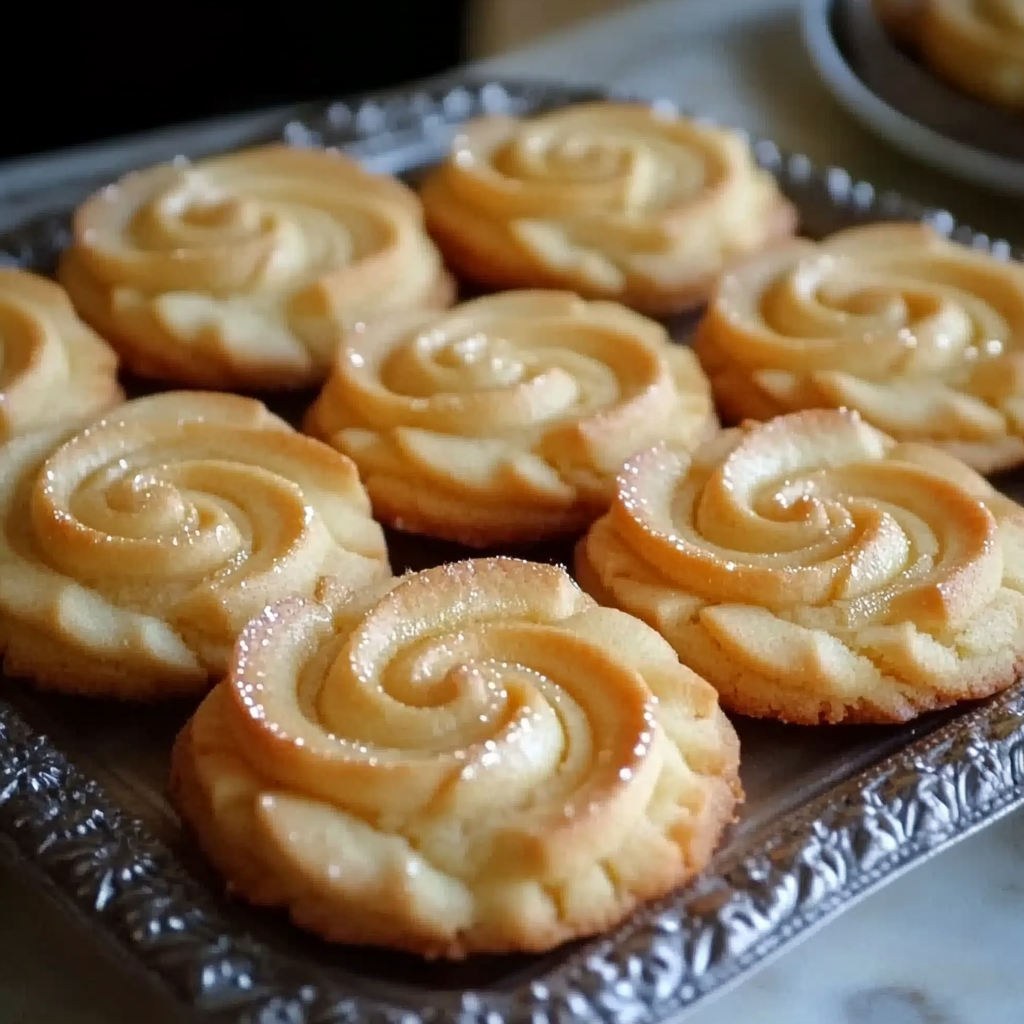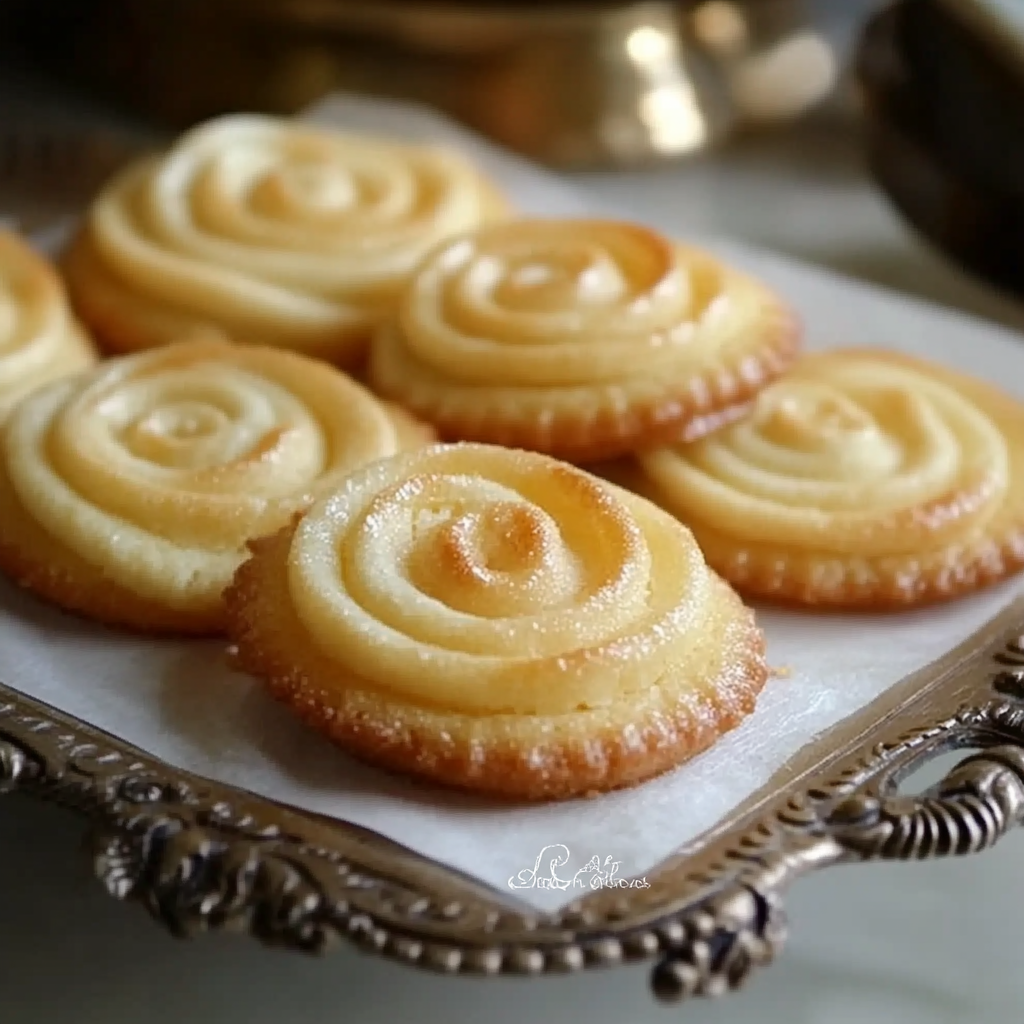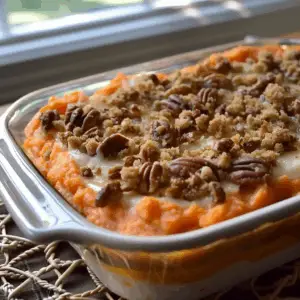French Shortbread Cookies
Few treats can match the elegance and simplicity of French shortbread cookies, known as sablés in their country of origin. These melt-in-your-mouth delicacies are celebrated for their rich, buttery texture and subtle sweetness. Originating from Sablé-sur-Sarthe, a town in northwestern France, this type of cookie has evolved into a classic staple in French baking tradition. Their crisp yet tender consistency and beautiful golden hue make them irresistible to cookie lovers and pastry aficionados alike.
What makes French shortbread cookies truly exceptional is their use of minimal, high-quality ingredients. This allows the primary component—butter—to shine through as the star of the recipe. If you’re craving a cookie that blends both texture and flavor in perfect harmony, look no further. A major twist in this recipe is the use of brown butter, or beurre noisette, which adds a distinct nutty depth that elevates the flavor far beyond traditional recipes. Curious about this rich French technique? Beurre noisette is a staple in both sweet and savory French dishes, and it’s surprisingly easy to master.
These cookies are also wonderfully versatile. Whether you’re preparing them for a cozy tea time, packaging them as gifts, or adding them to an elegant dessert spread, French shortbread cookies fit the bill. If you’re looking for more French cookie inspiration, explore this Pinterest board on French cookies. You’ll find endless ideas for shaping, decorating, and presenting these delicious bites.
Perfect for beginner bakers and seasoned pastry chefs alike, this recipe delivers sophistication without complication. You’ll only need a few ingredients—most of which are probably already in your pantry. Once you’ve tried these cookies, they’ll likely become a go-to for holidays, parties, or whenever your sweet tooth strikes.

What Are French Shortbread Cookies? (Sablés)
French shortbread cookies, traditionally called sablés, are an iconic part of French cuisine and have delighted dessert lovers for centuries. The term sablé translates to “sandy,” which reflects the cookie’s delicate, crumbly texture—a result of its high butter content and careful mixing method. Originating from the town of Sablé-sur-Sarthe in the Loire Valley, these cookies are deeply rooted in French baking heritage and are considered a refined staple in pâtisseries across the country.
Unlike American-style shortbread or sugar cookies, sablés are known for their rich, melt-in-the-mouth texture and subtle sweetness. Their charm lies in their simplicity: butter, sugar, flour, and sometimes eggs and vanilla extract. What differentiates them is the quality of the butter—ideally a high-fat, European-style butter, which creates a tender yet crisp bite. According to Wikipedia’s article on butter, using high-fat butter enhances the richness and structure of baked goods, especially in shortbread.
A defining characteristic of sablés is the absence of strong leavening agents. This results in a denser cookie that holds its shape beautifully, making it ideal for decorative shapes or sandwich cookies with jam or chocolate fillings. Their adaptability also makes them a favorite canvas for bakers looking to experiment with textures and flavors—from adding zests and nuts to infusing herbs or even dipping in chocolate.
For those exploring global cookie styles, the cookie varieties around the world include everything from chewy American classics to delicate French pastries. However, sablés remain distinct for their focus on buttery richness and delicate crumb. The cookies in this recipe stay true to that tradition, with a modern twist—browned butter—which gives them an added layer of nutty sophistication. If you’re looking for new ideas, explore sablé cookie styles on Pinterest to see how bakers across the world put creative spins on this French classic.
The Magic of Brown Butter (Beurre Noisette) in Baking
The use of brown butter, or beurre noisette, is a transformative step in baking that brings a deep, nutty complexity to any dessert—especially French shortbread cookies. Unlike regular melted butter, brown butter is cooked until the milk solids caramelize, releasing an aroma and flavor reminiscent of hazelnuts, hence the name noisette (French for “hazelnut”). It’s a small change with a big payoff that elevates simple recipes into gourmet creations.
To make brown butter, you start by melting unsalted butter over medium heat in a light-colored pan. This allows you to closely monitor the color change. As the butter melts, it begins to foam and sputter. Stir gently and consistently, watching as it shifts from yellow to golden brown. Within minutes, the milk solids at the bottom will toast, giving off a rich, nutty scent. Once browned, remove it from the heat immediately to prevent burning. The result is a golden, aromatic liquid that’s ready to infuse your dough with deep, layered flavor. For more details, check the Wikipedia page on beurre noisette which offers a concise overview of its culinary uses.
Adding brown butter to sablés not only intensifies the flavor but also complements other ingredients like vanilla, citrus zest, or even herbs. It blends beautifully with flour and sugar to produce a dough that’s not only flavorful but also easier to handle and shape. The nutty aroma of brown butter cookies is especially welcoming when served with warm drinks—browse tea and cookies pairings on Pinterest for serving inspiration.
Compared to traditional butter, brown butter contains less moisture and more concentrated fat, which helps develop a crisp edge while maintaining a tender interior. This textural contrast is key to the appeal of these cookies. It’s also worth noting that brown butter is a versatile ingredient in baking beyond cookies—it adds richness to cakes, frostings, and even savory dishes, making it a staple technique for serious home bakers and professionals alike.
If you’re new to working with brown butter, don’t worry—it’s surprisingly easy to master. Just keep your eyes on the pan, stir frequently, and enjoy the aromatic rewards. This simple French technique will instantly boost the sophistication and depth of your baked goods. For those looking to experiment further, brown butter baking ideas on Pinterest can spark creativity in the kitchen.
French Shortbread Cookies Recipe: Ingredients and Substitutes
Crafting the perfect batch of French shortbread cookies starts with assembling a handful of high-quality, straightforward ingredients. What makes this recipe shine is the focus on flavor-packed simplicity, allowing each component to play a vital role. Below is a breakdown of the ingredients and their roles, as well as thoughtful substitutions to suit various dietary needs.
Core Ingredients:
-
1 cup (2 sticks) unsalted butter, softened
This is the cornerstone of sablé cookies. Opt for high-fat, European-style butter for superior richness. Alternatively, brown the butter for a nutty, caramelized depth that enhances every bite. -
1 cup granulated sugar
Offers structure and sweetness. You may substitute with powdered sugar for a finer crumb or light brown sugar for a touch of molasses flavor. -
1 large egg
Adds moisture and helps bind the dough. If avoiding eggs, consider a flax egg or aquafaba as a substitute. See Wikipedia’s page on eggs in cooking for how they function in baked goods. -
2 ½ cups all-purpose flour
Provides the necessary structure. For a gluten-free option, use a blend of rice flour, cornstarch, and almond flour in equal parts. -
1 tsp vanilla extract
Enhances the flavor and complements the richness of the butter. For a deeper profile, try vanilla bean paste or even a dash of almond extract. -
¼ tsp salt
Balances the sweetness and amplifies the buttery notes.
Each ingredient plays a specific role in achieving that signature crumbly texture and buttery flavor. If you want to explore other ways of achieving similar effects, the Wikipedia article on shortbread outlines how proportions and ingredients affect the outcome.
Substitution Guide:
-
Vegan option: Replace the butter with a high-quality plant-based alternative and the egg with a flaxseed egg (1 tbsp ground flaxseed + 3 tbsp water).
-
Gluten-free variation: Substitute the all-purpose flour with a 1:1 gluten-free flour blend or try a homemade mix with almond flour and rice flour for extra flavor.
-
Sugar alternatives: While granulated sugar is standard, you can experiment with coconut sugar or monk fruit sweetener, though texture may vary.
For visual ideas on ingredient combinations and flavors, explore Pinterest’s French cookie inspiration boards, where bakers share their favorite twists on the classics. You can also browse examples of cookie varieties worldwide to compare ingredients and textures across cultures via this Wikipedia page.
Choosing the right ingredients doesn’t just affect taste—it influences the aroma, mouthfeel, and shelf life of your cookies. Stick to quality, and you’ll see how even the most minimalist recipes can deliver luxurious results.

Step-by-Step Instructions with Pro Tips
This French shortbread cookie recipe is straightforward, but a few pro techniques can make a big difference in your results. Follow this step-by-step guide to achieve perfectly crumbly, golden-brown cookies every time.
1. Preheat the Oven
-
Set your oven to 350°F (175°C).
-
Line your baking sheets with parchment paper. This ensures even baking and easy cleanup.
2. Brown the Butter (Optional but Recommended)
-
If using brown butter, melt the butter in a light-colored pan over medium heat.
-
Stir continuously until it turns golden brown and releases a nutty aroma.
-
Remove from heat and let it cool to room temperature before using.
Tip: For inspiration on brown butter variations, check out brown butter baking ideas on Pinterest.
3. Cream the Butter and Sugar
-
In a large bowl, beat the softened (or browned) unsalted butter with 1 cup of granulated sugar.
-
Mix until the texture is light and fluffy—this usually takes about 2–3 minutes with an electric mixer.
4. Add Egg and Vanilla
-
Beat in 1 large egg and 1 teaspoon of vanilla extract until fully incorporated.
-
Scrape the sides of the bowl to ensure everything is well mixed.
5. Incorporate Dry Ingredients
-
In a separate bowl, whisk 2½ cups of all-purpose flour with ¼ teaspoon of salt.
-
Gradually add the dry mixture to the wet ingredients. Mix just until a dough forms—do not overmix.
Note: Overmixing activates gluten, which can lead to tough cookies instead of the signature tender crumb.
6. Shape and Flatten the Dough
-
Roll the dough into small balls, about 1 inch in diameter.
-
Place them on the prepared baking sheet, spacing about 2 inches apart.
-
Gently flatten each ball with a fork or the bottom of a glass.
7. Bake to Perfection
-
Bake for 10–12 minutes, or until the edges are just turning golden.
-
Remove from oven and allow to cool on the sheet for 2–3 minutes before transferring to a wire rack.
Looking for elegant presentation ideas? Browse cookie gift packaging boards on Pinterest for creative styling.
Flavor Variations and Add-Ins
One of the joys of baking French shortbread cookies is how easy it is to infuse them with unique flavors. While the classic vanilla version is divine, consider these creative additions to give your cookies a personal twist:
-
Citrus Zest: Add 1 tsp of lemon or orange zest to the dough for a fresh, zippy finish.
-
Chocolate: Mix mini dark chocolate chips into the dough, or dip cooled cookies in melted chocolate.
-
Herbs: Incorporate ½ tsp finely chopped rosemary or dried lavender for a floral, French-inspired flair.
-
Spices: Add a dash of cinnamon or nutmeg for a warm, cozy touch.
Explore how other bakers flavor their sablés by browsing sablé cookie styles on Pinterest.
Storing and Freezing Tips
Proper storage keeps these delicate cookies fresh and flavorful:
-
At Room Temperature: Store in an airtight container for up to 1 week.
-
Freezing the Dough: Wrap dough tightly in plastic wrap, then freeze for up to 3 months. Thaw overnight in the fridge before baking.
-
Freezing Baked Cookies: Layer cookies between sheets of parchment paper in an airtight container and freeze for up to 2 months.
To re-crisp frozen cookies, warm them in a 300°F oven for 3–5 minutes.
Serving Suggestions and Occasions
These French shortbread cookies are ideal for a variety of settings, from casual gatherings to formal events. Consider these serving ideas:
-
With Tea or Coffee: A classic pairing. Explore tea and cookie pairings on Pinterest for inspiration.
-
Holiday Platters: Include them in a cookie tin or dessert board.
-
Gifts: Package in cellophane bags with ribbon or decorative tins for birthdays, holidays, or weddings.
They’re beautiful when dusted with powdered sugar or half-dipped in chocolate for an upscale look.
Common Mistakes to Avoid
Even a simple recipe like this can go wrong if key steps are missed. Here are common pitfalls and how to avoid them:
-
Overmixing the Dough: Leads to tough cookies. Mix just until combined.
-
Using Cold Butter: Prevents proper creaming. Always use room temperature or properly cooled brown butter.
-
Overbaking: These cookies should be lightly golden on the edges, not brown all over.
-
Skipping the Flattening Step: Results in uneven baking and undercooked centers.
Review the shortbread article on Wikipedia to understand the science behind proper cookie structure.
Healthier Alternatives (Optional Section)
Want to enjoy these cookies with less guilt? Try these simple adjustments:
-
Reduce Sugar: Cut sugar to ¾ cup for a milder sweetness.
-
Whole Wheat Flour: Substitute half the flour with whole wheat for added fiber.
-
Lactose-Free: Use clarified butter (ghee) or lactose-free butter for sensitive diets.
While these swaps will alter texture slightly, the flavor remains delicious.

FAQs
Q1. What is the difference between shortbread and sugar cookies?
Shortbread cookies use more butter and have a denser, crumbly texture. Sugar cookies often include more leavening and are lighter and softer.
Q2. Can I make French shortbread cookies without eggs?
Yes. Replace the egg with a flaxseed egg (1 tbsp ground flax + 3 tbsp water) or use 3 tbsp of applesauce. Note: texture will be slightly less crisp.
Q3. Why is my shortbread dough crumbly?
This usually happens if the butter is too cold or there’s not enough moisture. Warm the dough slightly or add a teaspoon of milk.
Q4. How long do homemade shortbread cookies last?
Stored in an airtight container, they stay fresh for up to 1 week. You can also freeze them for longer storage.
Q5. What does brown butter do in baking?
Brown butter adds a nutty, caramelized depth and reduces water content, resulting in a crisper cookie. Learn more from the beurre noisette entry.
Q6. Can I make these cookies gluten-free?
Absolutely. Use a gluten-free flour blend or combine almond, rice, and cornstarch flours.
Q7. Should I chill the dough before baking?
While optional, chilling for 30 minutes can help the cookies hold their shape and intensify flavor.
French Shortbread and Brown Butter Cookies You’ll Crave
A classic French shortbread cookie gets a modern twist with the nutty depth of brown butter. These delicate, crumbly cookies are rich in flavor and simple to prepare. With just a few basic ingredients, you can whip up a batch of elegant treats perfect for tea time, gifting, or any sweet craving.
- Author: Clara
Ingredients
- 1 cup (2 sticks) unsalted butter, softened
- 1 cup granulated sugar
- 1 large egg
- 2 ½ cups all-purpose flour
- 1 tsp vanilla extract
- ¼ tsp salt
Instructions
Preheat your oven to 350°F (175°C) and line baking sheets with parchment paper.
In a large bowl, cream together the softened butter and sugar until light and fluffy.
Beat in the egg and vanilla extract until well combined.
Gradually add in the flour and salt, mixing until a dough forms.
Shape the dough into small balls (about 1 inch in diameter) and place them on the prepared baking sheets, leaving space between each.
Flatten each ball slightly with a fork or the bottom of a glass.
Bake for 10-12 minutes, or until the edges are lightly golden.
Remove from oven and let cool on the baking sheet for a few minutes before transferring to a wire rack to cool completely.
Notes
-
Brown Butter Tip: Let your browned butter cool before mixing it with sugar to prevent melting the sugar and altering texture.
-
Flavor Options: Try adding lemon zest, rosemary, or dipping half in dark chocolate for variation.
-
Storage Reminder: Cookies keep well in an airtight container for up to a week and freeze beautifully for longer storage.




